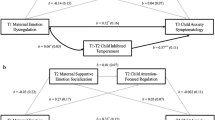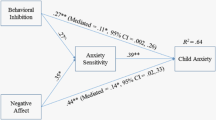Abstract
This longitudinal study tested whether associations between early attachment history and temperament and later anxiety symptoms are direct, or are indirect and explained by children’s competencies in regulating emotions and relating to peers. Attachment patterns (secure, avoidant, preoccupied, disorganized) were assessed at 15 and 36 months, and temperament (negative emotionality—NE, Shyness) was assessed at 54 months. Peer competence (PC) and the ability to manage intense emotions were assessed at early school age, and anxiety symptoms in preadolescence. Both attachment history and temperament predicted anxiety. PC mediated the relations of security and disorganization with anxiety, and the ability to manage intense emotions mediated the relation between security and anxiety. PC also mediated the relations of NE and shyness with anxiety, and the ability to manage intense emotions mediated the relation of NE with anxiety. The findings highlight specific mechanisms that may contribute to the development of anxiety.



Similar content being viewed by others
References
Albano AM, Chorpita BF, Barlow DH (2003) Childhood anxiety disorders. In: Mash EJ, Barkley RA (eds) Child psychopathology, 2nd edn. Guilford Press, New York, pp 279–329
Rapee RM, Schniering CA, Hudson JL (2009) Anxiety disorders during childhood and adolescence: origins and treatment. Annu Rev Clin Psychol 5:311–341
Brumariu LE, Kerns KA (2010) Parent–child attachment and internalizing symptoms in childhood and adolescence: a review of empirical findings and future directions. Dev Psychopathol 22(1):177–203
Bowlby J (1973) Attachment and loss: vol 2. Separation anxiety and danger. Basic Books, New York
Carlson EA, Sroufe LA (1995) Contribution of attachment theory to developmental psychopathology. In: Cicchetti D, Cohen DJ (eds) Developmental psychopathology, vol. 1: theory and methods. Wiley, Hoboken, pp 581–617
Lyons-Ruth K, Jacobvitz D (2008) Attachment disorganization: genetic factors, parenting contexts, and developmental transformation from infancy to adulthood. In: Cassidy J, Shaver PR (eds) Handbook of attachment: theory, research, and clinical applications, 2nd edn. Guilford Press, New York, pp 666–697
Brumariu LE, Kerns KA (2010) Mother–child attachment patterns and different types of anxiety symptoms: is there specificity of relations? Child Psychiatry Hum Dev 41(6):663–674
Brumariu LE, Kerns KA, Seibert A (2012) Mother-child attachment, emotion regulation, and anxiety symptoms in middle childhood. Pers Relatsh 19:569–585
Borelli JL, David DH, Crowley MJ, Mayes LC (2010) Links between disorganized attachment classification and clinical symptoms in school-aged children. J Child Fam Stud 19(3):243–256
Moss E, Smolla N, Cyr C, Dubois-Comtois K, Mazzarello T, Berthiaume C (2006) Attachment and behavior problems in middle childhood as reported by adult and child informants. Dev Psychopathol 18(2):425–444
Rothbart MK, Bates JE (2006) Temperament. In: Eisenberg N, Damon W, Lerner RM (eds) Handbook of child psychology: vol. 3, social, emotional, and personality development, 6th edn. Wiley, Hoboken, pp 99–166
Kagan J, Snidman N (1999) Early childhood predictors of adult anxiety disorders. Biol Psychiatry 46(11):1536–1541
Degnan KA, Almas AN, Fox NA (2010) Temperament and the environment in the etiology of childhood anxiety. J Child Psychol Psychiatry 51(4):497–517
Rubin KH, Coplan RJ, Bowker JC (2009) Social withdrawal in childhood. Annu Rev Psychol 60:141–171
Prior M, Smart D, Sanson A, Oberklaid F (2000) Does shy-inhibited temperament in childhood lead to anxiety problems in adolescence? J Am Acad Child Adolesc Psychiatry 39(4):461–468
Cicchetti D, Cohen DJ (1995) Perspectives on developmental psychopathology. In: Cicchetti D, Cohen DJ (eds) Developmental psychopathology, vol. 1: Theory and methods. Wiley, New York, pp 3–20
Bosquet M, Egeland B (2006) The development and maintenance of anxiety symptoms from infancy through adolescence in a longitudinal sample. Dev Psychopathol 18(2):517–550
Thompson RA, Meyer S (2007) Socialization of emotion regulation in the family. In: Gross JJ (ed) Handbook of emotion regulation. Guilford Press, New York, pp 249–268
Sroufe LA (1983) Infant-caregiver attachment and patterns of adaptation in preschool: the roots of maladaptation and competence. In: Perlmutter M (ed) Minnesota symposium on child psychology. Erlbaum, Hillsdale, pp 41–83
Kerns KA (2008) Attachment in middle childhood. In: Cassidy J, Shaver PR (eds) Handbook of attachment: theory, research, and clinical applications, 2nd edn. Guilford Press, New York, pp 366–382
Booth-LaForce C, Kerns KA (2009) Child–parent attachment relationships, peer relationships, and peer-group functioning. In: Rubin KH, Bukowski WM, Laursen B (eds) Handbook of peer interactions, relationships, and groups. Guilford Press, New York, pp 490–507
Schneider BH, Atkinson L, Tardif C (2001) Child–parent attachment and children’s peer relations: a quantitative review. Dev Psychol 37(1):86–100
Eisenberg N, Vaughan J, Hofer C (2009) Temperament, self-regulation, and peer social competence. In: Rubin KH, Bukowski WM, Laursen B (eds) Handbook of peer interactions, relationships, and groups. Guilford Press, New York, pp 473–489
Cole PM, Martin SE, Dennis TA (2004) Emotion regulation as a scientific construct: methodological challenges and directions for child development research. Child Dev 75(2):317–333
Cassidy J (1994) Emotion regulation: influences of attachment relationships. Monogr Soc Res Child Dev 59(2–3):228–283
Fox NA, Calkins SD (2003) The development of self-control of emotion: intrinsic and extrinsic influences. Motiv Emot 27(1):7–26
Kingery JN, Erdley CA, Marshall KC, Whitaker KG, Reuter TR (2010) Peer experiences of anxious and socially withdrawn youth: an integrative review of the developmental and clinical literature. Clin Child Fam Psychol Rev 13(1):91–128
Hannesdottir DK, Ollendick TH (2007) The role of emotion regulation in the treatment of child anxiety disorders. Clin Child Fam Psychol Rev 10(3):275–293
Vaughn BE, Bost KK, van IJzendoorn MH (2008) Attachment and temperament: Additive and interactive influences on behavior, affect, and cognition during infancy and childhood. In: Cassidy J, Shaver PR (eds) Handbook of attachment: theory, research, and clinical applications, 2nd edn. Guilford Press, New York, pp 192–216
NICHD (2001) Nonmaternal care and family factors in early development: an overview of the NICHD Study of Early Child Care. J Appl Dev Psychol 22(5):457–492
Ainsworth MDS, Blehar MC, Waters E, Wall S (1978) Patterns of attachment. Erlbaum, Hillsdale, NJ
NICHD (2006) Infant-mother attachment classification: risk and protection in relation to changing maternal caregiving quality. Dev Psychol 42(1):38–58
Cassidy J, Marvin RS (1992) Attachment organization in preschool children: procedures and coding manual. The Pennsylvania State University (unpublished coding manual)
Kerns KA, Seibert A (in press) Finding your way through the thicket: Promising approaches to assessing attachment in middle childhood. In: Waters E, Vaughn B, Waters HS (eds) Measuring attachment. Guilford Press, New York
Solomon J, George C (2008) The measurement of attachment security and related constructs in infancy and early childhood. In: Cassidy J, Shaver PR (eds) Handbook of attachment: theory, research, and clinical applications, 2nd edn. Guilford Press, New York, pp 383–416
Rothbart MK, Ahadi SA, Hershey KL (1994) Temperament and social behavior in childhood. Merril Palmer Quart 40(1):21–39
Rothbart MK (2007) Temperament, development, and personality. Curr Dir Psychol Sci 16(4):207–212
Gresham FM, Elliott SN (1990) The social skills rating system. American Guidance Service, Circle Pines
Larsen RJ, Diener E (1987) Affect intensity as an individual difference characteristic: a review. J Res Pers 21(1):1–39
Achenbach TM (1991) Manual for the Child Behavior Checklist/4-18 and 1991 Profile. University of Vermont, Department of Psychiatry, Burlington
Kerns KA, Siener S, Brumariu LE (2011) Mother–child relationships, family context, and child characteristics as predictors of anxiety symptoms in middle childhood. Dev Psychopathol 23(2):593–604
Enders CK, Bandalos DL (2001) The relative performance of full information maximum likelihood estimation for missing data in structural equation models. Struct Equ Model 8(3):430–457
MacKinnon DP, Lockwood CM, Hoffman JM, West SG, Sheets V (2002) A comparison of methods to test mediation and other intervening variable effects. Psychol Methods 7(1):83–104
Tofighi D, MacKinnon DP (2011) RMediation: an R package for mediation analysis confidence interval. Behav Res Methods 43:692–700
Spangler G, Grossmann K (1999) Individual and physiological correlates of attachment disorganization in infancy. In: Solomon J, George C (eds) Attachment disorganization. Guilford Press, New York, pp 95–124
Spangler G, Grossmann KE (1993) Biobehavioral organization in securely and insecurely attached infants. Child Dev 64(5):1439–1450
Diamond GS (2005) Attachment-based family therapy for depressed and anxious adolescents. In: Lebow JL (ed) Handbook of clinical family therapy. Wiley, Hoboken, pp 17–41
Siqueland L, Rynn M, Diamond GS (2005) Cognitive behavioral and attachment-based family therapy for anxious adolescents: phase I and II studies. J Anx Disorders 19:361–381
Vernberg EM, Abwender DA, Ewell KK, Beery SH (1992) Social anxiety and peer relationships in early adolescence: a prospective analysis. J Clin Child Psychol 21(2):189–196
Shields A, Cicchetti D (1997) Emotion regulation among school-age children: the development and validation of a new criterion Q-sort scale. Dev Psychol 33(6):906–916
Eisenberg N, Spinrad TL (2004) Emotion-related regulation: sharpening the definition. Child Dev 75(2):334–339
Acknowledgments
This study was based on data from the NICHD Study of Early Child Care. The NICHD support for the data collection is gratefully acknowledged. This study is based on a dissertation submitted by Laura E. Brumariu in partial fulfillment of the requirements for the Ph.D. degree.
Author information
Authors and Affiliations
Corresponding author
Rights and permissions
About this article
Cite this article
Brumariu, L.E., Kerns, K.A. Pathways to Anxiety: Contributions of Attachment History, Temperament, Peer Competence, and Ability to Manage Intense Emotions. Child Psychiatry Hum Dev 44, 504–515 (2013). https://doi.org/10.1007/s10578-012-0345-7
Published:
Issue Date:
DOI: https://doi.org/10.1007/s10578-012-0345-7




